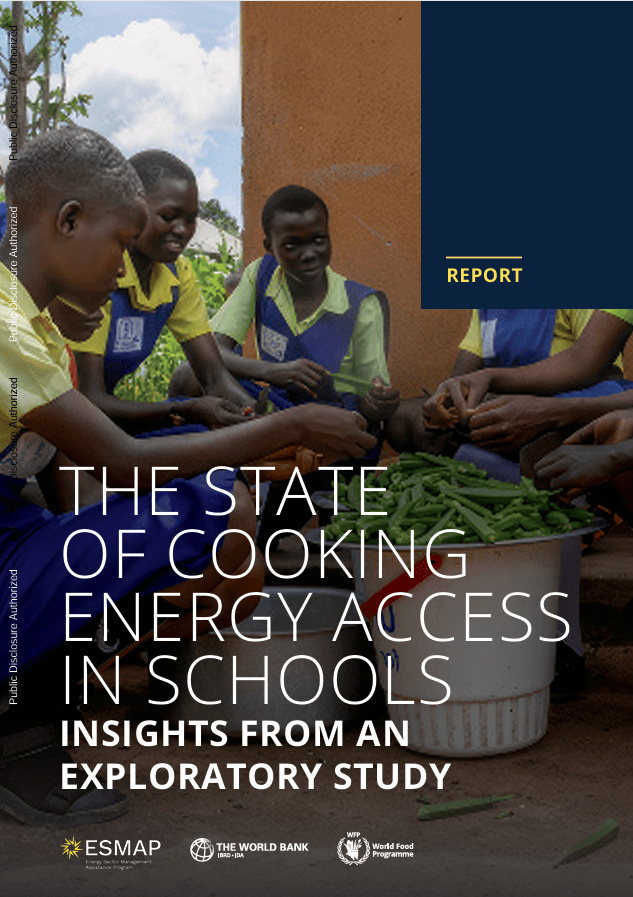The State of Cooking Energy Access in Schools
 |
Insights from an Exploratory Study
rapport Nov 2023 ; 92 pages
Ed. ESMAP - Washington
Téléchargeable chez l'éditeur
Résumé:
On estime à 418 millions le nombre d’enfants dans le monde qui reçoivent au moins un repas scolaire par jour. Cependant, dans les pays en développement, la plupart de ces repas sont préparés à l’aide de mélanges rudimentaires et polluants, avec des coûts encore peu connus pour la santé des élèves et du personnel, les finances scolaires et l’environnement local. Le manque de données sur l’ampleur du problème a limité la visibilité du secteur, conduisant à un faible niveau d'investissements pour répondre aux besoins des écoles en matière de cuisine propre.
Ce rapport, produit conjoint du Programme d’aide à la gestion du secteur de l’énergie (ESMAP) de la Banque mondiale et du Programme alimentaire mondial (PAM), utilise des données primaires et secondaires pour éclairer cet enjeu dans les écoles de pays à revenu intermédiaire, avec un accent particulier sur l’Afrique subsaharienne.
Les résultats révèlent un besoin urgent de sensibiliser tous les groupes d’intervenants, de produire des statistiques sectorielles fiables et de promouvoir la collaboration intersectorielle. Abstract:
Some 418 million children worldwide receive at least one school meal per day. However, in developing countries, most school meals are prepared using rudimentary, polluting biomass stove-and-fuel combinations, with unknown costs to the health of students and personnel, school finances, and the local environment. Scant data on the scale of the problem has limited the sector’s visibility, resulting in few investments being designed to meet the clean cooking needs of schools.
The State of Cooking Energy Access in Schools: Insights from an Exploratory Study, a joint product of the World Bank’s Energy Sector Management Assistance Program (ESMAP) and the World Food Programme (WFP), uses primary and secondary data to examine the issue in schools of low- and middle-income countries, with a strong focus on Sub-Saharan Africa.
The findings reveal an urgent need to raise awareness among all stakeholder groups, generate reliable sector statistics, and promote cross-sector collaboration.
Contents:
Chapter 1. Introduction 1
Overview 1
What are the costs of inaction? 1
Leveraging energy-sector trends and innovation 3
Study objective, methods, and scope 3
Structure of this report 5
Chapter 2. Cooking Energy Landscape 7
Introduction 7
Stove technologies and fuels 7
Prevalence of stacking 8
Sourcing of cooking fuels 8
Fuel consumption 9
Fuel expenditure and maintenance cost 10
Estimated impacts 12
Chapter 3. Clean Cooking Initiatives 15
Introduction 15
Entry points for addressing the challenge 15
Promoted technologies and fuels 20
Scale and phase of initiatives 21
Reported benefits of interventions 23
Initiatives in other regions 24
Annex 3. Initiatives outside Sub-Saharan Africa 26
Chapter 4. Delivery Approaches 31
Introduction 31
Design and implementation 31
Institutional arrangements 33
Policy and legal frameworks 34
Financing 37
Community participation 39
Chapter 5. Challenges and Opportunities 41
Introduction 41
Challenges 41
Opportunities 48
Chapter 6. Sector Outlook 53
Summary 53
Recommended actions 53
Study limitations 56
Looking ahead 56
Publics-Cibles:
Collectivité , Association , Acteurs de coopération , Socio-économiste , Economiste , Décideurs locaux ou nationaux
Mots clefs: |
accès à l'énergie (CI) (DT) (OP) (ope) , école (CI) (DT) (OP) (ope) , foyers, cuiseurs, améliorés (CI) (DT) (OP) (ope) |
Pays concernés: |
Burundi (CI) (DT) (OP) , Ghana (CI) (DT) (OP) , Inde (CI) (DT) (OP) , Kenya (CI) (DT) (OP) , Lesotho (CI) (DT) (OP) , Madagascar (CI) (DT) (OP) , Malawi (CI) (DT) (OP) , Mauritanie (CI) (DT) (OP) , Népal (CI) (DT) (OP) , Ouganda (CI) (DT) (OP) , Rwanda (CI) (DT) (OP) , Salvador (CI) (DT) (OP) , Timor Oriental (CI) (DT) (OP) , Venezuela (CI) (DT) (OP) |
Editeur/Diffuseur: |
|
ESMAP
-
Energy Sector Management Assistance Program - Washington - Etats Unis |
En cas de lien brisé, nous le mentionner à communication@pseau.org